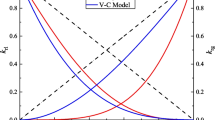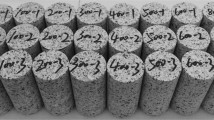Abstract
Triaxial tests on the two-phase flow of air and water through fractured granite specimens were performed to discover whether the two-phase fluid flow within rock fractures was laminar or turbulent. The two-phase flow characterization was carried out based on the macroscopic two-phase steady state flow model and the homogeneous steady state flow model. Rock specimens with a single natural fracture (joint roughness coefficient, JRC < 10) were tested using two-phase, high pressure triaxial rig. Experimental results show that the estimated Reynolds numbers for various inlet fluid pressures are well below 1000. The findings of this study reveal that both single and two-phase flow through rock fractures (JRC < 10) can be characterized as laminar flows at moderate inlet fluid pressures. However, for single-phase air flow, an increase in inlet air pressures may result in the formation of turbulent flow.





Similar content being viewed by others
References
Brown SR (1987) Fluid flow through rock joints: effects of surface roughness. J Geophys Res 92(B2):1337–1347
Gangi AF (1978) Variation of whole and fractured porous rocks permeability with confining pressure. Int J Rock Mech Min Sci Geomech Abstr 15:249–257
Itasca Consulting Group (1996) User’s manuals: version 3.0, vol 1, 2 and 3. UDEC-Universal Distinct Element Code, USA
Iwai K (1976) Fundamental studies of fluid flow though a single fracture. PhD thesis, University of California, Berkeley
Lomize G (1951) Fluid flow in fissured formation (in Russian). Moskva-Leningrad
Louis CA (1976) Introduction à l’hydraulique des roches. PhD thesis, Paris
Olsson R (1998) Mechanical and hydromechanical behaviour of hard rock joints a laboratory study. PhD thesis, Chalmers University of Technology
Ranjith PG (2000) Analytical and experimental modeling of coupled water and air flow through rock joints. PhD thesis, University of Wollongong, Australia
Ranjith PG, Choi Sk, Fourar M (2006) Characterization of two-phase flow in a single rock joint. Int J Rock Mech Min Sci 43:216–223
Schrauf TW, Evans DD (1986) Laboratory studies of gas flow through a single natural fracture. Water Resour Res 22:1038–1050
Street RL, Gary ZW, John KV (1996) Elementary fluid mechanics, 7th edn. Wiley, New York, p 757
Tsang YW (1984) The effect of tortuosity on fluid flow through a single fracture. Water Resour Res 20:1209–1215
Tsang YW, Witherspoon PA (1981) Hydro-mechanical behavior of a deformable rock fracture subjected to normal stress. J Geophys Res 86(B10):9287–9298
Witherspoon PA, Wang JSY, Iwai K, Gale JE (1980) Validity of cubic law for fluid flow in a deformable rock fracture. Water Resour Res 16(6):1016–1024
Zimmerman RW, Bodvarsson GS (1996) Hydraulic conductivity of rock fractures. Transport in porous media, vol 23. Kluwer, Dordrecht, pp 1–30
Author information
Authors and Affiliations
Corresponding author
Rights and permissions
About this article
Cite this article
Ranjith, P.G. An experimental study of single and two-phase fluid flow through fractured granite specimens. Environ Earth Sci 59, 1389–1395 (2010). https://doi.org/10.1007/s12665-009-0124-3
Received:
Accepted:
Published:
Issue Date:
DOI: https://doi.org/10.1007/s12665-009-0124-3




